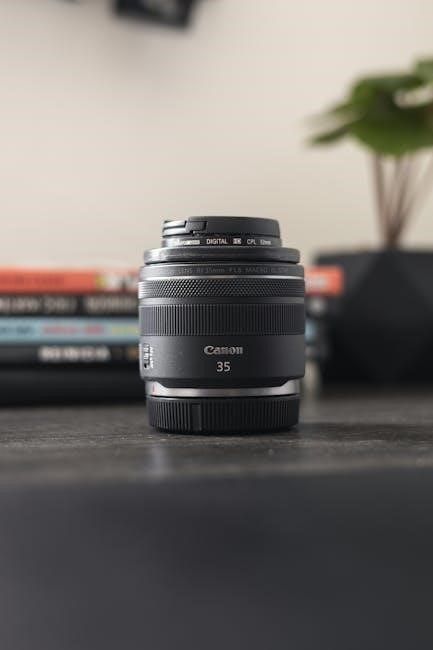canon ae 1 manual camera
The Canon AE-1, introduced in 1981, is a 35mm film SLR camera known for its simplicity, versatility, and microprocessor-controlled exposure, making it a favorite among photographers.
Overview of the Canon AE-1 Program
The Canon AE-1 Program is a 35mm film SLR camera introduced in 1981, designed to blend simplicity with advanced features. It gained popularity for its user-friendly interface and versatility, appealing to both amateur and professional photographers. The camera features microprocessor-controlled exposure, a first in its class, offering three automatic exposure modes: Programmed AE, Shutter-Speed Priority AE, and AE Flash. Additionally, it allows manual override for creative control. The AE-1 Program supports Canon FD lenses and includes features like automatic film advance and battery-powered operation. Its compact design and intuitive controls made it a landmark camera in photography history, balancing ease of use with professional-grade functionality.
Historical Significance and Popularity
The Canon AE-1, introduced in 1981, holds a significant place in photography history as one of the first cameras to use a microprocessor for exposure control. Its launch marked a turning point for Canon, establishing the brand as a leader in the camera industry. The AE-1’s popularity stemmed from its affordability, user-friendly design, and advanced features, making it accessible to both amateurs and professionals. It became a cultural icon, symbolizing the democratization of photography. The camera’s compact size and intuitive controls appealed to a broad audience, while its versatility and reliability solidified its reputation. Today, the AE-1 remains a beloved classic, cherished by collectors and photographers alike for its enduring influence on the evolution of photography.
Key Features and Innovations
The Canon AE-1 introduced groundbreaking features, blending manual control with advanced automation. It was the first camera to utilize a microprocessor, enabling precise automatic exposure calculations. The AE-1 offered three modes: Program AE, Shutter-Speed Priority AE, and Manual mode, providing flexibility for diverse shooting scenarios. Its compatibility with Canon FD lenses expanded creative possibilities. The camera featured a built-in TTL metering system and a vertical-travel focal-plane shutter with speeds from 2 to 1/1000 seconds. The AE-1’s ergonomic design and intuitive controls made it user-friendly, appealing to both professionals and novices. Its innovative use of electronics and mechanical engineering set a new standard for SLR cameras, making it a benchmark for future designs and a timeless favorite among photographers. Its durability and functionality ensured its lasting impact on the photography world.
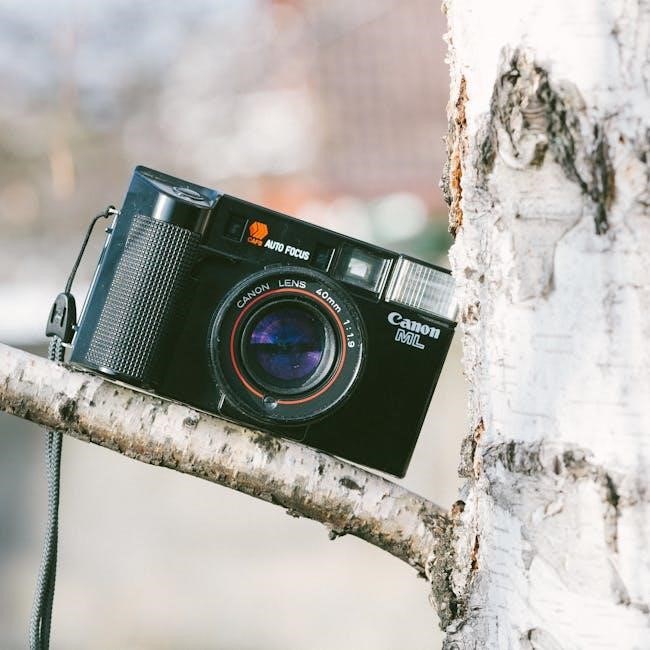
Camera Specifications and Components
The Canon AE-1 is a 35mm SLR film camera introduced in 1981, featuring Program AE, Shutter-Speed Priority AE, and Manual modes. It uses FD lenses and includes a vertical-travel focal-plane shutter with speeds up to 1/1000 seconds.
Technical Details and Capabilities
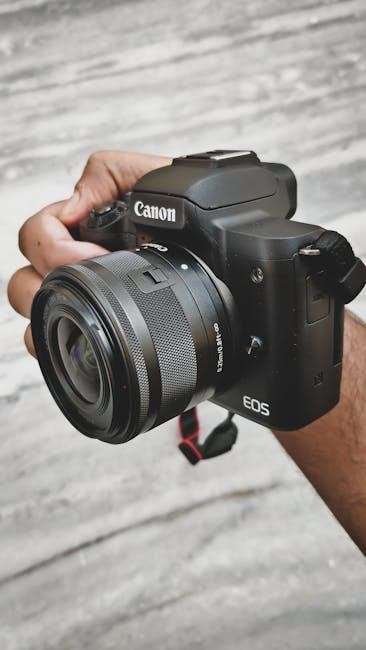
The Canon AE-1 is a 35mm film SLR camera introduced in 1981, featuring a microprocessor-controlled exposure system. It offers Program AE, Shutter-Speed Priority AE, Manual, and AE Flash modes. The camera includes a vertical-travel focal-plane shutter with speeds from 2 seconds to 1/1000th of a second and a synchronized flash speed of 1/60th of a second. The ISO range is 12 to 3200, accommodating various film types. The AE-1 is powered by a 6-volt silver-oxide battery and is compatible with Canon FD lenses, though non-FD lenses can be used with manual adjustments. Its advanced features and durability made it a popular choice for both amateurs and professionals.
Compatibility with Canon FD Lenses
The Canon AE-1 is specifically designed to work seamlessly with Canon FD lenses, ensuring optimal performance and automatic exposure control. These lenses feature a green indexing mechanism, which aligns with the camera’s metering system for precise aperture and shutter speed calculations. While non-FD lenses can be used, they require manual adjustments, as the AE-1’s microprocessor-controlled exposure system relies on FD lens communication. This compatibility ensures photographers can leverage a wide range of high-quality Canon FD lenses, from wide-angle to telephoto, to achieve professional-grade results. The FD lens system enhances the camera’s versatility, making it a preferred choice for both amateur and professional photographers seeking reliable and high-performance optics.
Automatic Exposure (AE) Modes
The Canon AE-1 offers three automatic exposure (AE) modes: Programmed AE, Shutter-Speed Priority AE, and Aperture Priority AE, providing flexibility for various shooting scenarios. Programmed AE automatically sets both shutter speed and aperture for optimal exposure, while Shutter-Speed Priority AE allows manual control over shutter speed, with the camera adjusting the aperture. Aperture Priority AE enables manual aperture selection, with the camera adjusting the shutter speed accordingly. These modes are made possible by the camera’s advanced microprocessor, which calculates exposures with precision. Additionally, the AE-1 supports manual override for complete control, catering to both novice and advanced photographers. The camera’s compatibility with Canon FD lenses further enhances its AE capabilities, ensuring accurate metering and seamless functionality.

Setting Up and Operating the Camera
Attach the lens, load film, set ASA, and insert the 6-volt battery. Use the film advance lever to cock the shutter and prepare for shooting with ease.
Mounting the Lens and Initial Setup
Mounting the lens on the Canon AE-1 is straightforward. Align the red dots on the lens and camera, then twist to secure. Ensure the lens clicks into place for proper connection. Next, install the 6-volt silver-oxide battery by opening the compartment on the front. Use a small screwdriver to release the latch. After battery installation, set the ASA film speed by pushing the film advance lever away and adjusting the dial. These steps prepare the camera for loading film and capturing photos. Refer to the manual for detailed diagrams and instructions to ensure correct setup and optimal performance.
Loading Film and Battery Installation
Inserting the 6-volt silver-oxide battery into the Canon AE-1 is essential for operation. Open the battery compartment, located on the front, using a small screwdriver. Place the battery inside, ensuring proper alignment. For film loading, open the camera back by pulling the release lever. Align the film leader with the take-up spool, ensuring it advances correctly. Close the back and advance the film by turning the lever until it stops. Set the film speed using the ASA dial. These steps ensure the camera is ready for shooting. Always refer to the manual for precise instructions to avoid errors during setup.
Understanding and Using AE Modes
The Canon AE-1 offers three automatic exposure (AE) modes: Programmed AE, Shutter-Speed Priority AE, and AE Flash. In Programmed AE, the camera automatically selects both aperture and shutter speed for optimal exposure. Shutter-Speed Priority allows manual control of shutter speed, with the camera adjusting the aperture accordingly. AE Flash mode enables flash photography while maintaining automatic exposure control. To use these modes, ensure the lens is set to the “AE” position and the film speed is correctly set. The microprocessor calculates exposure based on light meter readings, providing accurate results. These modes cater to both beginners and professionals, offering flexibility and ease of use while capturing high-quality images. Understanding these modes enhances your ability to adapt to various shooting conditions effectively.
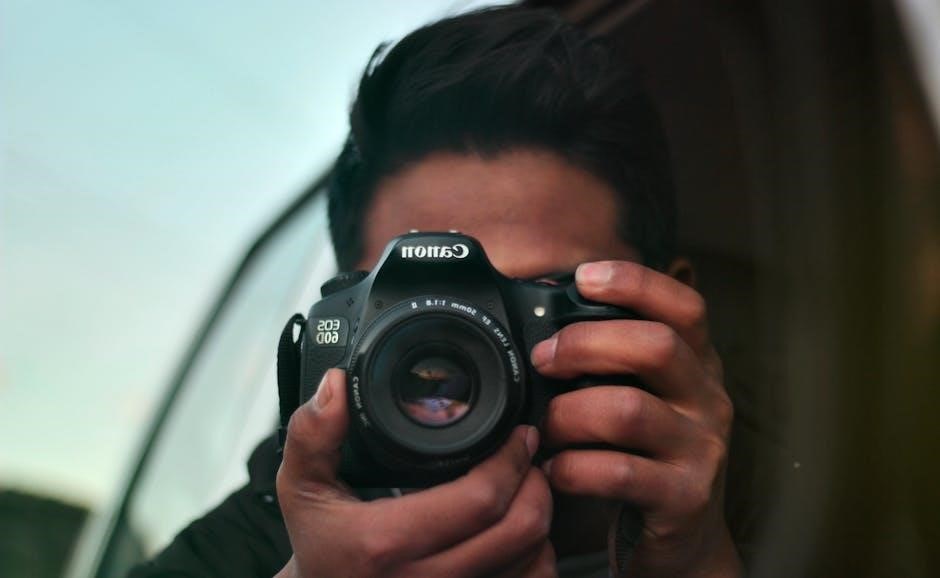
Advanced Features and Functions
The Canon AE-1 features microprocessor-controlled exposure, offering advanced modes like Shutter-Speed Priority and Programmed AE, while allowing manual overrides for precise control over settings and customization.
Microprocessor-Controlled Exposure
The Canon AE-1 was groundbreaking for its time, featuring the first microprocessor in a camera. This innovation enabled precise automatic exposure control, allowing photographers to achieve consistent results. The microprocessor analyzed light meter readings to adjust aperture and shutter speed seamlessly. This technology simplified photography, making it accessible to both amateurs and professionals. The microprocessor also supported advanced modes like Shutter-Speed Priority and Programmed AE, enhancing the camera’s versatility. By integrating this cutting-edge technology, the AE-1 set a new standard in photography, ensuring accurate exposures and expanding creative possibilities for its users. This feature remains a testament to the camera’s enduring influence in the world of photography.
Shutter-Speed Priority and Programmed AE
The Canon AE-1 offers two advanced exposure modes: Shutter-Speed Priority and Programmed AE. In Shutter-Speed Priority, users can manually set the shutter speed, while the camera automatically adjusts the aperture for optimal exposure. This mode is ideal for capturing motion or freezing action. Programmed AE, on the other hand, allows the camera to automatically select both shutter speed and aperture, providing convenience for photographers who prefer hands-off operation. These modes leverage the camera’s microprocessor to ensure precise exposures. Additionally, manual override is available, giving photographers the flexibility to adjust settings as needed. These features make the AE-1 versatile for various shooting scenarios, catering to both casual and professional use. The combination of automation and manual control sets the AE-1 apart as a highly adaptable camera.
Manual Override and Custom Settings
The Canon AE-1 allows photographers to take full control of their shots with manual override and custom settings. While the camera offers advanced automatic modes, users can manually adjust aperture, shutter speed, and other settings for precise control. This feature is particularly useful for experienced photographers who want to experiment with creative techniques or adapt to unique lighting conditions. The manual override enables photographers to bypass the automatic exposure settings, allowing for complete customization. Custom settings can be made using the camera’s aperture ring and shutter speed dial, ensuring flexibility and adaptability in various shooting scenarios. This blend of automation and manual control makes the AE-1 a versatile tool for photographers seeking both convenience and creative freedom. The manual override feature is especially praised for its ease of use and precision, catering to both professionals and enthusiasts alike.
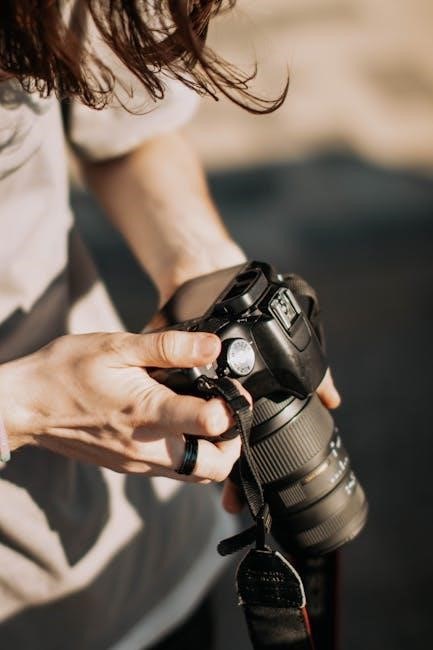
Maintenance and Troubleshooting
Regular cleaning of the lens, viewfinder, and camera body ensures optimal performance. Battery care is crucial; avoid damaged batteries to prevent internal damage. Common issues include torn shutter curtains, requiring professional servicing for repair. Proper storage and handling prevent mechanical wear, ensuring the AE-1’s longevity and reliability for years of use.

Cleaning and Care Tips
Regular maintenance ensures the Canon AE-1’s longevity. Use a soft, dry cloth to clean the camera body and lens, avoiding harsh chemicals. For the viewfinder and mirrors, a microfiber cloth and gentle pressure suffice. Store the camera in a dry, cool place, away from direct sunlight, to prevent moisture and dust buildup. Use a protective case when not in use. Clean the battery compartment with a cotton swab to ensure proper power flow. Avoid touching the shutter curtains to prevent damage. For stubborn lens smudges, use a lens cleaning tissue with care. Regularly inspect and clean the FD lens mount to maintain compatibility. Proper care ensures the AE-1 remains functional and ready for use, preserving its quality for years of photography.

Common Issues and Solutions
Like any vintage camera, the Canon AE-1 can experience issues. Battery drain or failure is common, solved by using a 6-volt silver-oxide battery or an LR44 adapter. Film loading issues often arise from improper alignment; ensure the film leader is securely attached. Shutter curtains can stick due to age, requiring professional servicing. Lens incompatibility is another concern, as only Canon FD lenses work in AE modes. For non-FD lenses, switch to manual mode. Corrosion in the battery compartment can prevent power flow; clean it with a cotton swab. If the camera fails to meter, check the battery and ensure the lens is properly mounted. Regular cleaning and maintenance can prevent many of these issues, ensuring the AE-1 continues to function reliably for years.
Battery and Power Management
The Canon AE-1 requires a 6-volt silver-oxide battery (4LR44 or PX28) for its electronic functions. To install, open the battery compartment at the front using a small screwdriver. Avoid metal tools to prevent damage. The camera does not drain the battery in “B” or bulb mode, nor does it require power for mechanical shutter speeds like 1/90 second or manual mode. For extended use, consider using an LR44 battery adapter. If the camera is unused for long periods, remove the battery to prevent leakage. Ensure the compartment is clean and dry to maintain proper electrical contact. Regularly check battery life to avoid unexpected power loss during shooting. Proper power management ensures reliable performance and extends the camera’s operational life.

Additional Resources and Support
Downloadable PDF manuals, third-party guides, and online forums provide comprehensive support for the Canon AE-1, offering detailed instructions, troubleshooting, and community discussions for enhanced user experience.
Downloadable PDF Manuals
The Canon AE-1 manual is widely available as a downloadable PDF, offering detailed instructions for setup, operation, and troubleshooting. These manuals can be found on official Canon websites, as well as third-party resources like Butkus.us and Internet Archive. They provide step-by-step guides for mounting lenses, loading film, and using automatic exposure modes. Additionally, the PDFs include technical specifications, diagrams, and maintenance tips. Some versions are optimized for users with disabilities, such as DAISY files. Manuals are available in multiple languages, including English and German, ensuring global accessibility. These resources are invaluable for both newcomers and experienced photographers, helping them maximize the camera’s capabilities and resolve common issues; Downloading the PDF manual is a convenient way to access comprehensive guidance anytime, making it an essential tool for Canon AE-1 users.
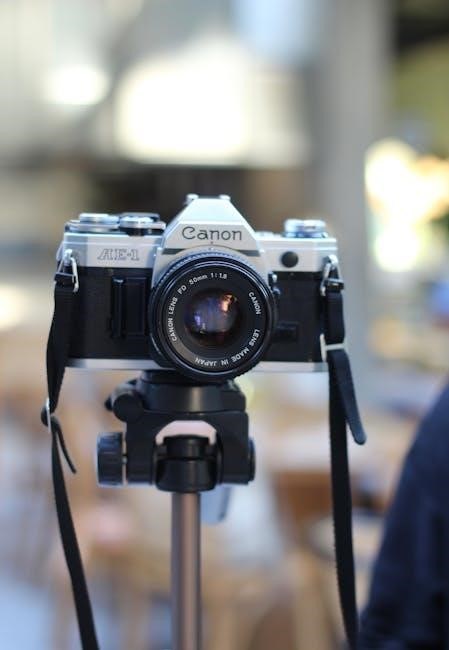
Third-Party Guides and Tutorials
Beyond the official manual, numerous third-party guides and tutorials are available online, offering in-depth insights and practical tips for using the Canon AE-1. Websites like Butkus.us and Internet Archive provide comprehensive PDF manuals and supplementary materials. FlynnGraphics and LensInc offer detailed tutorials on camera setup, lens compatibility, and troubleshooting. Additionally, YouTube channels and photography forums feature video guides and community discussions, sharing hands-on experiences and expert advice. These resources often include step-by-step instructions for loading film, using automatic exposure modes, and maintaining the camera. They also cover advanced techniques, such as manual overrides and custom settings, making them invaluable for both beginners and experienced photographers seeking to master the Canon AE-1.
Online Communities and Forums
Online communities and forums dedicated to the Canon AE-1 serve as vibrant hubs for enthusiasts to share knowledge, ask questions, and showcase their work. Platforms like Reddit’s r/photography and specialized forums offer extensive discussions on camera techniques, troubleshooting, and accessory recommendations. Members often share personal experiences with the AE-1, including tips on lens compatibility, film recommendations, and maintenance tips. These communities also host galleries where users can display their photos, providing inspiration and learning opportunities. Additionally, many forums compile FAQs and repair guides, addressing common issues like battery management and shutter repair. Such collaborative spaces foster a sense of camaraderie among photographers, making them invaluable resources for anyone looking to optimize their use of the Canon AE-1.
